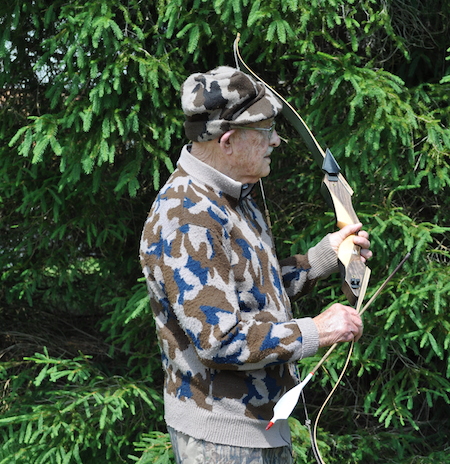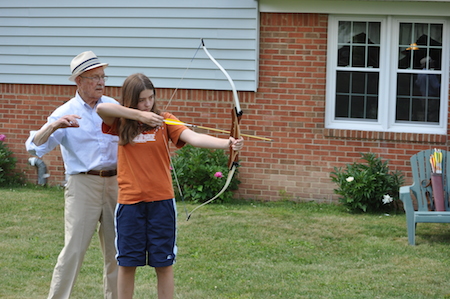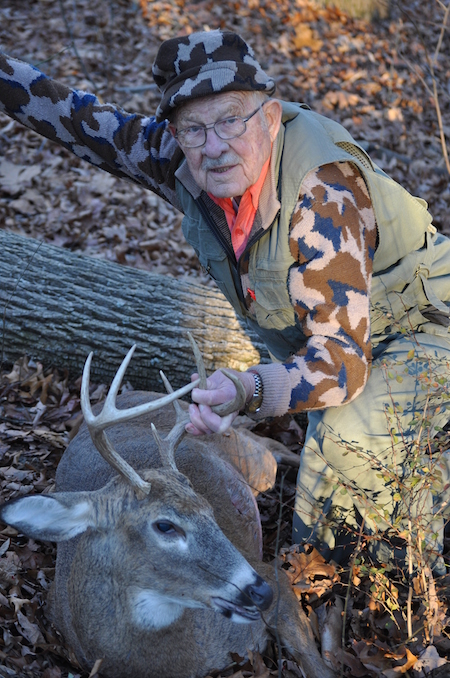Claude Jones promised his wife he would quit bowhunting from treestands when he turned 75. He kept his promise. That was eighteen years ago. Arthritis has bothered him for the last few years, and he has considered giving up bowhunting altogether. Still, every year he goes out even if it is only for a few days.
Jones got a late start at hunting with a bow. He was staring at middle age when a chance encounter sparked an interest in archery.
Jones was born September 28, 1921,in Rappahannock County, Virginia. After graduating from high school in 1939, he worked for a few years before joining the Army Signal Corps. The Corps was offering an education in electronics and radio to qualified individuals, something he was interested in. Jones tested and was accepted.
First he studied elementary electronics and RADAR, then moved on to advanced RADAR. This was at the beginning of World War II and RADAR was Top Secret. Jones advanced to the point that, for a time, he taught electronics at Camp Murphy in Florida. After he was discharged from the Army in 1946, he went into commercial radio. Today, regulations are much more relaxed, but at that time a Federal Communications Commission First Class broadcasting license was required to work in radio. He did electrical work, such as house wiring, to make a living while he studied for the test. Once he had his license, he took a job in California. That lasted three years, then he came back to the East Coast and worked at a station in Maryland. After that, he worked at several stations in Virginia, and in 1961 he came to WRON in Ronceverte, West Virginia.
One of the jobs he had at WRON was interviewing owners of small businesses in the listening area. In 1965, he interviewed Richard Cross, owner of Pocahontas Archery in nearby White Sulphur Springs. Pocahontas turned out a line of quality archery equipment at a time when archery was not very popular. With that interview the seed was sown. The following payday, Jones drove over to Pocahontas Archery and bought a 62-inch recurve for $30. At first, Jones was only interested in shooting at targets. He had hunted deer with a rifle in California and didn’t care too much for it. After shooting his bow for a year or so, he realized bowhunting would be a real challenge, and he started thinking, “Could I get a deer with a bow?”
That was at a time when many hunters looked at bowhunting as a novelty, and bowhunters were just show-offs. Real deer hunters used rifles! Undaunted, Jones gave it a try. He didn’t get a deer the first year, but the second year, on November 22, 1969, he killed a spike.
From the beginning he has used recurves. He has shot longbows at targets, but never hunted with one. “I don’t like the looks of a compound,” he said. “They look like a piece of farm machinery.” Currently he has nine bows. Among them is a longbow he made from a hickory stave.
“The heaviest bow I ever used was 60 pounds. That’s way heavier than I can handle these days. To tell you the truth, I couldn’t draw a 50 pound bow to anchor and hold it. I know–I tried it a few days ago! My favorite bow for a number of years now is a 40 pound take-down that I bought in the rough and finished. That 60 pound bow I had, I gave to my oldest son.”
 At first he bought arrows, but for many years now he has made his own. Over the years he has bought materials from several companies, some that have gone out of business. His favorite today is 3Rivers. “Although I have used aluminum, fiberglass and carbon, I really prefer wood and I have used several types of wood. I like the feel of wood and I like the smell of wood. I have a friend who hunts turkeys. He usually gets two a year and saves me the left wings for fletching. I use Rit dye to color them, then split the quill with a knife and grind it down with my sander.”
At first he bought arrows, but for many years now he has made his own. Over the years he has bought materials from several companies, some that have gone out of business. His favorite today is 3Rivers. “Although I have used aluminum, fiberglass and carbon, I really prefer wood and I have used several types of wood. I like the feel of wood and I like the smell of wood. I have a friend who hunts turkeys. He usually gets two a year and saves me the left wings for fletching. I use Rit dye to color them, then split the quill with a knife and grind it down with my sander.”
He started out using 2-blade broadheads and experimented with various brands. Now he uses 3-blade Woodsman heads. “The Woodsman is easy to sharpen and it won’t wind plane. I shot them at 60 to 70 yards in the wind just to see. They won’t wind plane!”
As a hobby and for decorations, Jones makes primitive arrows. “I killed one deer with a flint-tipped arrow. The only one I ever shot at. I just did it because I wanted to see what it would do. And it is just like any other arrowhead, if you put it in the right place it will kill. I was never much good a knapping arrowheads, but I have a friend who is. He is a doctor and a former Army Ranger. He uses flint, chert and occasionally glass. I get all the arrowheads I need from him.”
Jones uses a CatQuiver back quiver. On this type, the fletching is covered and protected from the elements. Arrows are lifted slightly and drawn out the side.
 Since that first deer in 1969, Jones estimates he has killed somewhere between 40 and 50 deer, several squirrels and rabbits, and two turkeys. “The first one, I was turkey hunting from a blind. A fairly big jake was working its way toward me. It bent over to pick at something on the ground and I shot it right in the middle of the back. When the arrow hit, the turkey came up and flew about 8-10 feet, fell to the ground and flopped. The second one I got while I was deer hunting. A hunter had wounded it, and it was limping along. When it got within range, I shot it.”
Since that first deer in 1969, Jones estimates he has killed somewhere between 40 and 50 deer, several squirrels and rabbits, and two turkeys. “The first one, I was turkey hunting from a blind. A fairly big jake was working its way toward me. It bent over to pick at something on the ground and I shot it right in the middle of the back. When the arrow hit, the turkey came up and flew about 8-10 feet, fell to the ground and flopped. The second one I got while I was deer hunting. A hunter had wounded it, and it was limping along. When it got within range, I shot it.”
Although he will never forget his first deer, probably the most memorable one is also his best. Memorable due to the length of time he watched it feed toward him. “There’s a great adrenaline rush in bowhunting that will last sometimes quite a while. The 8-point I showed you, I watched it for half a mile. I was set up at the edge of a 35-40 acre field. I watched that deer come into the extreme far end of the field, and I watched it for a period of nearly an hour. The ground was not level and as the deer came toward me I would lose it every so often. I kept my binoculars on the spot where I last saw it. Eventually, I would see the antlers again. Something like that is hard on your nerves. When it got within 30 yards, I took the shot. I was proud of myself that day. I knew it was a good rack because I had watched it through the binoculars for so long.
“I still have the arrow there on the rack. It’s an arrow I made from hickory. A heavy, rugged arrow with a Woodsman head.”
 To keep his body in shape, and to tone his muscles, Jones exercises with a rowing machine and a pair of dumbbells.
To keep his body in shape, and to tone his muscles, Jones exercises with a rowing machine and a pair of dumbbells.
For several years, Jones has hunted from a permanent ground blind on a farm owned by an old friend and fellow hunter. It’s big enough for him to shoot standing up, although he usually shoots sitting down. “If you are sitting down and a deer comes along you don’t always have time to stand up. I would rather shoot standing; I’m more accurate that way. I would say I’ve shot two-thirds of my deer standing up. The blind is very comfortable. It is completely enclosed. It has two windows so I can shoot out either side if I want to. When it gets really cold, I have a small gas heater I can light and stay as warm as toast. Sometimes I don’t take my bow with me. I just sit there and read or watch the deer. Of course I always take my camera with me.” After arthritis began bothering him, he tried a crossbow and did get a deer with it, but hunting with a crossbow is just not his cup of tea.
Jones was successful in both the 2011 and 2012 seasons. In 2013, he was only able to go out for a short while and, unfortunately, was not successful.
 In 2014, Jones got a shot of cortisone to help deal with his arthritis. He really wanted to get a deer. An old friend of his from Alaska came to visit and brought him five pounds of moose meat. He wanted to be able to give his friend five pounds of venison to take back to Alaska. On the afternoon of November 15, a nice doe presented a perfect broadside shot well within range. When the arrow hit, she bolted, ran about 20 yards and laid down. At the age of 93, Jones had killed one more deer. He is, quite possibly, the oldest bowhunter in the United States.
In 2014, Jones got a shot of cortisone to help deal with his arthritis. He really wanted to get a deer. An old friend of his from Alaska came to visit and brought him five pounds of moose meat. He wanted to be able to give his friend five pounds of venison to take back to Alaska. On the afternoon of November 15, a nice doe presented a perfect broadside shot well within range. When the arrow hit, she bolted, ran about 20 yards and laid down. At the age of 93, Jones had killed one more deer. He is, quite possibly, the oldest bowhunter in the United States.
It’s now 2015. When the frosty nights and the warm, sunny, fall days come, will Claude be content to hang up his bow and live with his memories and take only his camera with him into the blind? We’ll see.
Ben Crookshanks is a freelance writer who lives in Greenbrier County, West Virginia.


This July I’ll be 80, in 2017 I arrowed my first 8 point deer at 40 yards. That was my goal, so now I’m not so enthusiastic. I have my NYS Lifetime Super Senior Sportsman Hunting License. I’m in excellent health so I just might continue to Bow-hunt, maybe for 10 more years or more.